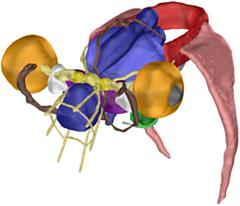Project 3721: A. Ziegler, C. Sagorny. 2021. Holistic description of new deep sea megafauna (Cephalopoda: Cirrata) using a minimally invasive approach. BMC Biology. 19 (1):null.

Specimen: Grimpoteuthis imperator Ziegler & Sagorny, 2021 (ZMB/Moll:240160)
View: Oblique
View: Oblique
Abstract
Background: In zoology, species descriptions conventionally rely on invasive morphological techniques, frequently leading to damage of the specimens and thus only a partial understanding of their structural complexity. More recently, non-destructive imaging techniques have successfully been used to describe smaller fauna, but this approach has so far not been applied to identify or describe larger animal species. Here, we present a combination of entirely non-invasive as well as minimally invasive methods that permit taxonomic descriptions of large zoological specimens in a more comprehensive manner.Results: Using the single available representative of an allegedly novel species of deep-sea cephalopod (Mollusca: Cephalopoda), digital photography, standardized external measurements, high-field magnetic resonance imaging, micro-computed tomography, and DNA barcoding were combined to gather all morphological and molecular characters relevant for a full species description. The results show that this specimen belongs to the cirrate octopod (Octopoda: Cirrata) genus Grimpoteuthis Robson, 1932. Based on the number of suckers, position of web nodules, cirrus length, presence of a radula, and various shell characters, the specimen is designated as the holotype of a new species of dumbo octopus, G. imperator sp. nov. The digital nature of the acquired data permits a seamless online deposition of raw as well as derived morphological and molecular datasets in publicly accessible repositories.
Conclusions: Using high-resolution, non-invasive imaging systems intended for the analysis of larger biological objects, all external as well as internal morphological character states relevant for the identification of a new megafaunal species were obtained. Potentially harmful effects on this unique deep-sea cephalopod specimen were avoided by scanning the fixed animal without admixture of a contrast agent. Additional support for the taxonomic placement of the new dumbo octopus species was obtained through DNA barcoding, further underlining the importance of combining morphological and molecular datasets for a holistic description of zoological specimens.
Read the article »
Article DOI: 10.1186/s12915-021-01000-9
Project DOI: 10.7934/P3721, http://dx.doi.org/10.7934/P3721
| This project contains |
|---|
Download Project SDD File |
Currently Viewing:
MorphoBank Project 3721
MorphoBank Project 3721
- Creation Date:
30 April 2020 - Publication Date:
23 April 2021 - Media downloads: 31

Authors' Institutions ![]()
- Rheinische Friedrich-Wilhelms-Universität Bonn (University of Bonn)
Members
| member name | taxa |
specimens |
media | media notes |
| Alexander Ziegler Project Administrator | 1 | 1 | 41 | 41 |
| Christina Sagorny Full membership | 0 | 0 | 0 | 0 |
Project has no matrices defined.
Project downloads 
| type | number of downloads | Individual items downloaded (where applicable) |
| Total downloads from project | 140 | |
| Media downloads | 31 | M740074 (4 downloads); M740042 (4 downloads); M740050 (3 downloads); M740038 (4 downloads); M740075 (2 downloads); M740041 (2 downloads); M740047 (1 download); M740045 (3 downloads); M740053 (1 download); M740039 (2 downloads); M740071 (1 download); M740051 (1 download); M740076 (1 download); M740073 (1 download); M740077 (1 download); |
| Project downloads | 107 | |
| Document downloads | 2 | Grimpoteuthis imperator organs (1 download); Grimpoteuthis imperator lower beak (1 download); |
